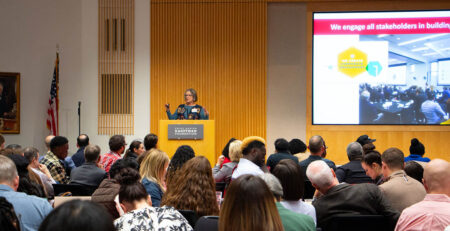Great Scott! 6 Movie-Inspired Tips to Help Your KC Business Onboard New Hires
Just like it’s cheaper to retain an existing customer than it is to acquire a new one, it’s more cost-effective and time-efficient to retain an employee than hire someone new. We all inherently know this, yet we still spend a disproportionate amount of time on recruiting and hiring new employees compared with our efforts to keep the staff we have. It takes more than a ping pong table and craft beer in the breakroom to make your new hires feel welcome.
The shortest path to converting new employees into ambassadors for your brand and making them feel like part of the team starts with a well-thought-out onboarding process. Plus, it doesn’t cost a thing.
In 2018, I was the third, full-time hire at LEANLAB Education, a KC-based non-profit and KCSourceLink Resource Partner. Since then, we’ve nearly quadrupled our staff. As the vice president of operations and communications, I oversee the hiring and onboarding process. I learned quickly that hiring and onboarding present specific challenges for growing businesses and startups. Because articles about ‘onboarding processes’ tend to be boring, here are my onboarding tips using iconic movie quotes to help you retain those new hires:
1. “You’re gonna need a bigger boat.” – Jaws, 1975
Unless you’re filling a vacated role, you’re hiring because your company is growing.
Growing too quickly can hurt a company’s culture, especially a startup’s. You may feel like you desperately need extra hands on deck ASAP, but before you rush to add a team member, first evaluate whether you need a “bigger boat.”
What systems that worked for three people, won’t work for five?
How might you need to shift some of your organizations’ basic structures when another hire comes on board?
Scrutinize everything from professional development, team meetings and one-on-ones to your approval processes, tech stack and company credit cards. Avoid growing pains by anticipating bottlenecks before they happen.
2. “Nobody puts Baby in a corner.” – Dirty Dancing, 1987
When your new hire starts, the only relationships they will have on the team are with the people they went through the interview process with (who are probably in a position of power).
Connect your new hire with their peers and proactively design ways for them to build rapport with other team members quickly. Quick wins include assigning some of your staff to help out with onboarding new hires and embedding new hires in ongoing projects to get them deeply involved with the rest of the team.
3. “Elementary, my dear Watson.” – The Adventures of Sherlock Holmes, 1939
Somewhere along the line, the business community decided that “90 days” is the amount of time it takes to get a team member up to speed and fully functioning in the new role. Have you ever felt fully functioning in a new role in your first 90 days? Me neither.
In my experience, it takes about a year or so to “get into flow.” In her first couple of months, your new hire has to learn about your organization, your sector, your culture, your working norms and your jargon. It’s a lot to take in and can be overwhelming.
Avoid inundating them with too much information, too soon. Give them the basic context they need to do their jobs well in the beginning and give them ongoing support as they settle into their role.
4. “My precious.” – The Lord of the Rings: Two Towers, 2002
Here’s a scenario: You have too much on your plate and can’t clone yourself, so you do the next best thing and hire someone to lighten your workload. Whether you’re a founder or an employee at a young business, you’ve already developed habits and gotten comfortable with the way you do things at ‘Company X’. Now is the time to remember that you hired someone for their expertise.
Inevitably, your new employee might look at the way you do things and pick them apart. Now is not the time to be too precious or get defensive. Open yourself up to feedback and take advantage of their fresh eyes. Approach this time with a growth mindset and listen to and incorporate their feedback. Before you shoot down an idea, consider trying a new approach and experimenting with it.
5. “Roads? Where we’re going, we don’t need roads.” – Back to the Future, 1985
Unless you just filled a call center job, your new hire isn’t expecting to work from a script. Build trust and demonstrate confidence in your new employee by allowing her some freedom to flex her creativity.
It doesn’t need to be anything high stakes, either. You can have her tackle something internal-facing like a new feedback system or low-stakes marketing asset. Either way, giving her ownership to build something and do it her way will help her feel involved in the work and your organization. Plus, she might spot a new way to approach a challenge that you were too close to the problem to see.
In my experience, onboarding goes best when you help new employees learn through discovery.
6) “I don’t know how to put this, but I’m kind of a big deal.” – Anchorman, 2004
Put yourself in their shoes: You’ve just completed an interview process that was for the most part, one-sided, competitive and stressful. Of all the applicants, you got the job by highlighting how incredible you are, and now you have to deliver and prove to the hiring managers that they made the right decision.
No one lands a new job and wants to feel like they’re not living up to expectations. That’s why it’s important at the beginning of a working relationship to give your new team members affirming, positive feedback. This will help them build their confidence and evolve more quickly into a high-performing member of your growing team.
Onboarding is a taxing but necessary aspect of bringing new hires up to speed and integrating them into your team. Use these six tips to ensure a smooth onboarding process every time.
Stephanie Campbell is vice president of communications and operations at LEANLAB Education a Kansas City-based, non-profit organization that introduces transformational innovations and technology to K-12 schools through community-centered research and provides support to education entrepreneurs.




Leave a Reply